
views
- Minor cases of cat acne don’t require any treatment and may disappear on their own.
- Put a warm compress on cat acne to help open the pores and bring down inflammation.
- Wash cat acne with a chlorhexidine antibacterial wash to kill germs that lead to infection. Alternatively, you can use a benzoyl peroxide shampoo.
- Visit a vet if your cat develops large pimples or open lesions. They’ll prescribe topical or oral antibiotics.
Home Treatment

Apply a warm compress to your cat's skin. Soak a washcloth in warm water and wring it out completely. Hold the damp cloth against your cat's chin for about 2–4 minutes. That way, your kitty’s pores will open up so they’re easier to wash or apply medicine to. Warm compresses can help bring down swelling or inflammation, and may be enough to clean out your cat’s pores. Use a warm compress at least once a day while your cat has feline acne.
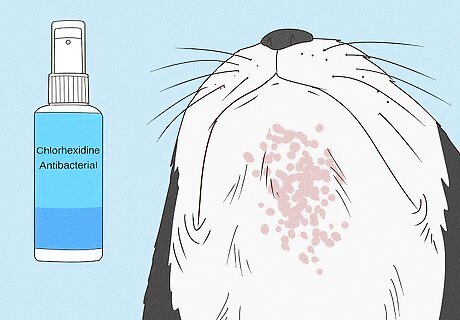
Clean the acne spots with chlorhexidine antibacterial wash. Chlorhexidine is an antiseptic that helps kill microbes that could cause feline acne or lead to infections. Spray the chlorhexidine wash directly on the blackheads where your cat has acne. You can apply chlorhexidine 2–3 times a day to help clear up the acne. Alternatively, you can get chlorhexidine wipes and gently wipe the spot with cat acne. As an alternative home remedy, try wiping your cat’s acne with a cotton ball soaked with witch hazel. Steer clear of alcohol- or peroxide-based wipes since they could irritate your cat’s skin.
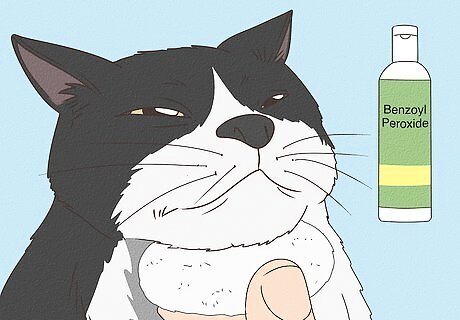
Wash your cat with benzoyl peroxide shampoo. Benzoyl peroxide is an antiseptic that penetrates deep to get rid of acne and kill germs on your cat's skin. Wet your cat’s fur with warm water where they have acne spots and gently work the shampoo into a lather using a cotton ball or washcloth. Stay with your cat and let the shampoo sit for at least 5 minutes before rinsing it off. Use benzoyl peroxide shampoo 1–2 times each day on your cat. Some benzoyl peroxide shampoos also contain salicylic acid, which is another antiseptic cleaner that can help treat acne. Avoid picking at or trying to pop any of the acne spots since it can be really painful for your cat and possibly lead to an infection.
Vet Diagnosis and Treatment
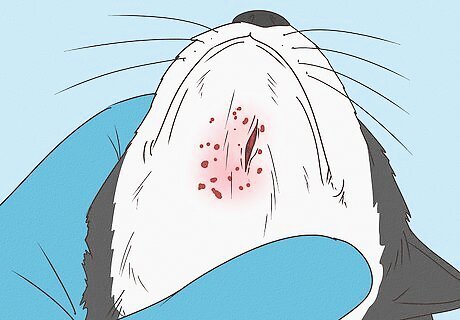
Take your cat to the vet if they have swollen pimples or open wounds. Feline acne usually looks like small black dots or dirt. If the blemishes swell up or look red and inflamed, it may mean there’s a sign of infection or bacteria. To be on the safe side, set up a vet appointment to make sure your cat doesn’t get sick or have any other conditions. Cat acne is pretty common, so there’s no need to be concerned if you see fewer than 20 small black spots. They might not even bother your cat and could disappear on their own.
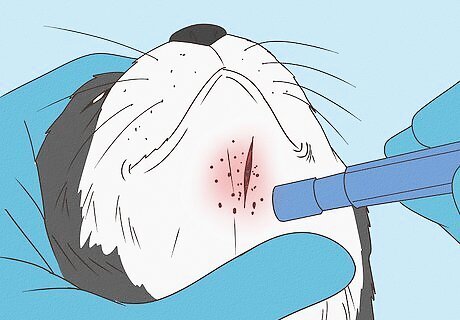
Have your vet take a skin sample to rule out other infections. Your vet will scrape a small sample from your cat’s skin to run tests. That way, they can make sure your cat isn’t suffering from a different skin condition with similar symptoms. Your vet may also check the sample for mites, bacteria, or fungi as well.
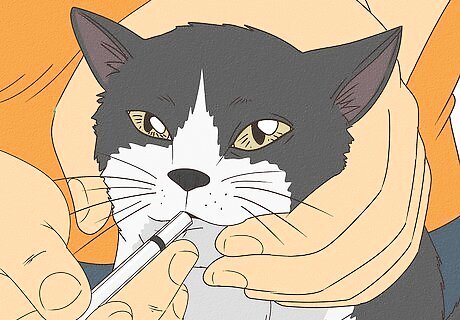
Give your cat antibiotics if your vet prescribes them. Your vet will either prescribe a topical or oral medication if your cat has a severe case of acne. To give your cat oral medication, either use a medicine dropper or mix it with their next meal. If you’re using a topical medication, rub it onto your cat’s acne so it absorbs into their skin. You’ll usually have to give your cat antibiotics for 4–6 weeks. Your cat may need to take steroids to reduce inflammation in severe cases of feline acne.
Symptoms
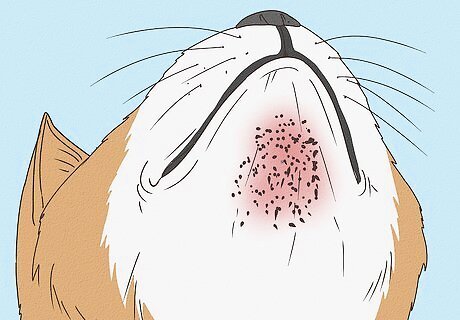
Small black chin spots or bumps Typically, acne lesions form near your cat's chin. If you see any small and firm black spots, then your feline friend has comedones, or blackheads, growing. If you stroke your cat just under the chin, the blackheads will make their skin feel gritty. Cat acne can also form around your cat’s upper lip. Small blackheads could swell into larger pimples. If your cat scratches at them, you might notice small scabs or a rough texture on your cat’s chin. If your cat has acne around the base of their tail, then treat them for “stud tail.”

Greasy or discolored chin As oils build up in your cat’s fur, they may develop yellow discolorations around their chin. When you pet them, their fur and skin may feel oily where acne is developing.

Itchy chin Feline acne can make your cat feel a little itchy, so you may see them scratching more frequently than they usually do.
What causes cat acne?
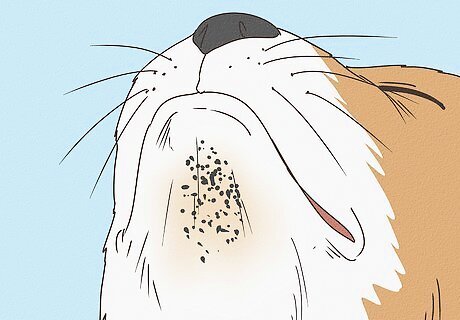
Sebum buildup Your cat makes an oily substance called sebum that helps them maintain their fur and mark their scent. Sometimes, your cat produces too much sebum, which can plug their hair follicles and form blackheads.

Poor grooming habits Your cat may have a tricky time cleaning spots like their chin when they get messy. If your furry friend still has some food stuck in their fur and they don’t clean themselves, the bacteria could lead to cat acne.
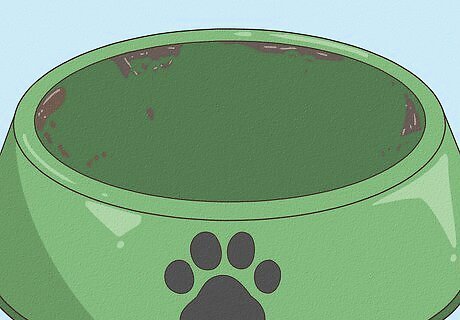
Dirty or plastic food dishes Bacteria can easily form in food and water bowls if they sit out for a long time. Plastic also harbors more bacteria that cause acne than glass or metal.
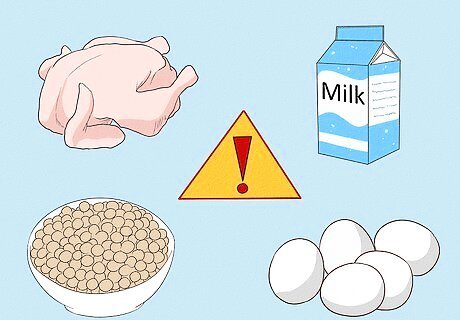
Food allergies Allergies can cause inflammation or irritation on your cat’s skin, so it could potentially lead to them developing acne.

Stress Just like how humans break out when they get stressed, your cat may have a similar reaction if they aren’t able to feel calm and relaxed.
How do I stop my cat from getting chin acne?

Wipe your cat’s mouth and chin daily. When your cat is calm and relaxed, wet a cotton ball or washcloth with some water and gently rub it over your cat’s skin. That way, you can lift up any excess oil or food particles and prevent them from irritating your cat’s skin.
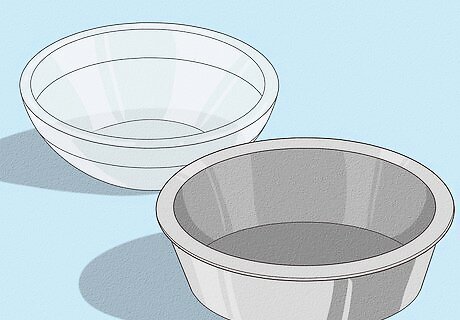
Get metal or glass bowls for your cat’s food and water. It’s tougher for bacteria to grow on glass or metal, so there are fewer chances of your furry friend getting cat acne on their chin. Wash the dishes every day with soapy water to keep them clean and bacteria-free.

Change your cat’s diet if you suspect food allergies. Talk to your vet and ask them about what cat food would work best for your cat. When you transition your cat to a new diet, offer them the old and new food at mealtimes. When your cat starts eating the new food regularly, wean them off of their old food by about 1 tablespoon per day. Watch your cat’s acne while you’re switching food. If their acne seems to get worse, go back to their old diet and consult your vet.

Create a calm stress-free environment for your cat at home. Cats can be sensitive to stress and changes around them, but you can do a lot to help them relax. Make a comfortable space for your cat with their bed and some toys so they have a safe spot to hide. Pet your cat and give them some attention every day to create a daily routine. Try to avoid making loud noises and having lots of people over since all the commotion can stress your cat. If your cat still acts stressed out, talk to your vet to see if they can prescribe a calming medication.




















Comments
0 comment